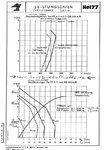I found this document on Luftwaffe Cockpitinstrumente Homepage Titelseite Instrumente Gertebrett Baumuster
I have found various references to the max speed of the He177 from 480 kph to 521 kph at 6800m. This chart shows about 550 kph at climb and combat power of 2500ps each at 1.3 ata. So how fast does it go at 2710 ps each at 1.42 ata at the same altitude?
I have found various references to the max speed of the He177 from 480 kph to 521 kph at 6800m. This chart shows about 550 kph at climb and combat power of 2500ps each at 1.3 ata. So how fast does it go at 2710 ps each at 1.42 ata at the same altitude?

